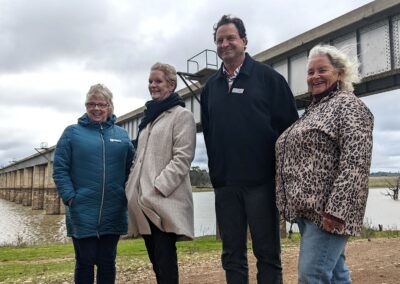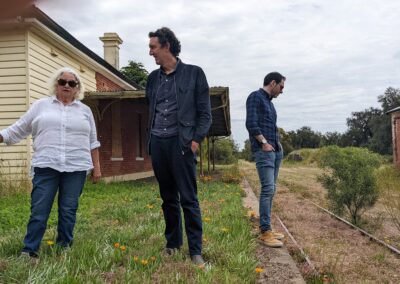
99% trail is ‘VERY obvious’, but a few tricky bits: experts
16 March, 2022
Our consulting experts are about half way into their six month study looking at the trail’s feasibility and economic and social upsides. They include urban planners, tourism economists and engineers, and they’ve been along the trail and mixing in our communities.

Project steering committee and CMRT member John Carruthers caught up with FFLA lead consultant Tim Fitzgerald to talk about the study, early findings and where to from here.
What kind of stuff has the expert team been wrestling with the past few weeks?
Two things we’ve been focussing upon in recent weeks have been discussions with the key authorities who have responsibilities along the potential trail alignment – organisations including VicTrack. We’ve been checking potential trail alignment options: 99% of the alignment is very obvious, because it follows the former rail line. The tricky bits are where we are trying to link the trail to key destinations and facilities, and to find the safest ways to cross major roads.
What’s ahead for the next few weeks?
We’re working our way through our list of stakeholders and having discussions to try to learn as much as we can about the opportunities and any issues associated with the potential trail. Also, our trail investigations thus far have been focussed on the sections near towns. We’ll shortly be assessing all of the bits in between, including things like checking the condition of existing bridges.
Are you planning to talk to the Council experts? Maybe out into the communities?
We’ve already spoken to most of our targeted council experts, and have just a few more to speak to. We’ve had some valuable insights from them, particularly in relation to related projects they’re undertaking. We’re finalising details for community listening posts in Castlemaine and Maryborough at the moment, along with an online community survey. Communities along the trail, please stay tuned!
What’s the most important thing you’ve uncovered recently?
There are some other council projects underway that align really closely with the work we’re doing and the concept of the trail. It’s been great to have some detailed discussions with council officers. We’ve uncovered some opportunities.
What’s the most surprising thing you’ve uncovered so far?
The Moolort Plains section of the trail has been a real surprise. It’s quite a different landscape to other parts of the trail. The wetlands have been looking great after all of the rain. I think the challenge will be to make sure people get a sense of how amazing the Moolort landscape is when using the rail trail.
What have you learned about the trail by looking during the summer months?
We’ve been lucky that it hasn’t been a very hot summer. Normally we’d be working around fire risk, but flooding has been the more prominent issue this year. It has been useful to be undertaking the assessments after a flood event, because you get a very clear idea about the flood potential along the route.
Tim Fitzgerald is an urban planner and principal with urban designers FFLA, veterans of other trail studies. Co-delivering the study is tourism and development economist Jonathan Rochwerger from Urban Enterprise, with engineering advice from civil engineers Newton Kerr + Partners construction engineers, with project management from RMCG’s David Hale.
The feasibility study aims to test the proposition that a world class trail can be established between Castlemaine and Maryborough along the disused rail corridor, contributing up to $8 million in annual economic uplift to the two shires.
The funding for the feasibility study was underpinned by $18,000 donated by CMRT supporters and $12,000 contributed by the shires of Mt Alexander and Central Goldfields. The Victorian Government anchored the study with a $120,000 grant through its enabling tourism fund. CMRT led the joint bid for the grant funds with the two shires.
The Victorian Government’s tourism grant was announced in June by Bendigo West MLA Maree Edwards, and Tourism, Sport and Major Events Minister, Martin Pakula.



